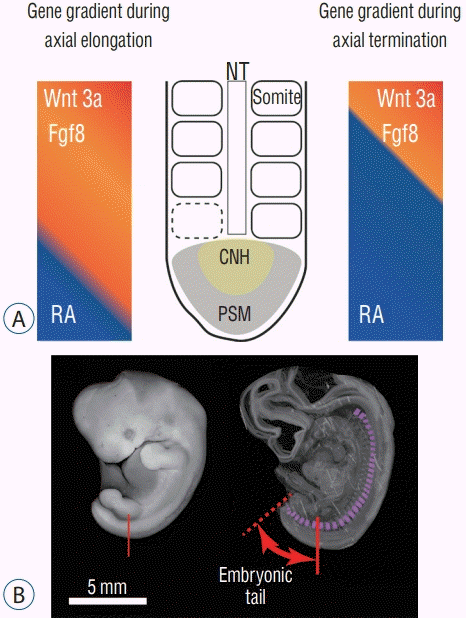1. Altmann SA. A field study of the sociobiology of rhesus monkeys, Macaca mulatta. Ann N Y Acad Sci. 102:338–435. 1962.
2. Ankel F. Der canalis sacralis als indikator für die länge der caudalregion der primaten. Folia Primatol (Basel). 3:263–276. 1965.

3. Ankel F. Vertebral morphology of fossil and extant primates in Tuttle R (ed) : The Functional and Evolutionary Biology of Primates. ed 1. New York: Aldine;1972. p. 223–240.
4. Bernstein PL, Smith WJ, Krensky A, Rosene K. Tail positions of Cercopithecus aethiops. Z Tierpsychol. 46:268–278. 1978.

5. Burke AC, Nelson CE, Morgan BA, Tabin C. Hox genes and the evolution of vertebrate axial morphology. Development. 121:333–346. 1995.
6. Dubrulle J, McGrew MJ, Pourquié O. FGF signaling controls somite boundary position and regulates segmentation clock control of spatiotemporal
Hox gene activation. Cell. 106:219–232. 2001.

7. Economides KD, Zeltser L, Capecchi MR. Hoxb13 mutations cause overgrowth of caudal spinal cord and tail vertebrae. Dev Biol. 256:317–330. 2003.

8. Fallon JF, Simandl BK. Evidence of a role for cell death in the disappearance of the embryonic human tail. Am J Anat. 152:111–129. 1978.

9. Favier B, Rijli FM, Fromental-Ramain C, Fraulob V, Chambon P, Dollé P. Functional cooperation between the non-paralogous genes Hoxa-10 and Hoxd-11 in the developing forelimb and axial skeleton. Development. 122:449–460. 1996.

10. Fleagle JG. Primate Adaptation and Evolution. ed 3. San Diego: Academic Press;2012.
11. Fooden J. Comparative review of fascicularis-group species of macaques (Primates: Macaca). Fieldiana Zoology. 2006:1–43. 2006.
12. Fooden J, Albrecht GH. Tail-length evolution in fascicularis-group macaques (Cercopithecidae: Macaca). Int J Primatol. 20:431–440. 1999.
13. German RZ. The functional morphology of caudal vertebrae in New World monkeys. Am J Phys Anthropol. 58:453–459. 1982.

14. Hall KR. Behaviour and ecology of the wild patas monkey, Erythrocebus patas, in Uganda. J Zool. 148:15–87. 1966.

15. Harrison RG. On the occurrence of tails in man, with a description of the case reported by Dr. Watson. Bull Johns Hopkins Hosp. 12:96–101. 1901.

16. Itani J. Takasakiyama no saru (Japanese monkeys in Takasakiyama) in Imanishi K (ed) : Nihon-Dobutsuki. Tokyo: Kobunsha;1954.
17. Larson SG, Stern JT Jr. Maintenance of above-branch balance during primate arboreal quadrupedalism: coordinated use of forearm rotators and tail motion. Am J Phys Anthropol. 129:71–81. 2006.

18. Maroto M, Bone RA, Dale JK. Somitogenesis. Development. 139:2453–2456. 2012.

19. Nakatsukasa M, Tsujikawa H, Shimizu D, Takano T, Kunimatsu Y, Nakano Y, et al. Definitive evidence for tail loss in Nacholapithecus, an East African Miocene hominoid. J Hum Evol. 45:179–186. 2003.

20. Nakatsukasa M, Ward CV, Walker A, Teaford MF, Kunimatsu Y, Ogihara N. Tail loss in Proconsul heseloni. J Hum Evol. 46:777–784. 2004.

21. Ojha PR. Tail carriage and dominance in the rhesus monkey, Macaca mulatta. Mammalia. 38:163–170. 1974.

22. Organ JM. Structure and function of platyrrhine caudal vertebrae. Anat Rec (Hoboken). 293:730–745. 2010.

23. Roonwal ML, Tak PC. A field study of subspecific variation in tail form and carriage in the rhesus macaque, Macaca mulatta (Primates). South Asia Bull Zool Surv India. 4:95–101. 1981.
24. Saga Y. The mechanism of somite formation in mice. Curr Opin Genet Dev. 22:331–338. 2012.

25. Sawada A, Shinya M, Jiang YJ, Kawakami A, Kuroiwa A, Takeda H. Fgf/MAPK signalling is a crucial positional cue in somite boundary formation. Development. 128:4873–4880. 2001.

26. Shapiro LJ. Functional morphology of the vertebral column in primates in Gebo D (ed) : Postcranial Adaptation in Nonhuman Primates. DeKalb: Northern Illinois University Press;1993. p. 121–149.
27. Shapiro LJ. Functional morphology of indrid lumbar vertebrae. Am J Phys Anthropol. 98:323–342. 1995.

28. Tojima S. Tail length estimation from sacrocaudal skeletal morphology in catarrhines. Anthropol Sci. 121:13–24. 2013.

29. Tojima S. Variation of the number of proximal caudal vertebrae with tail reduction in old world monkeys. Primates. 55:509–514. 2014.

30. Tojima S. Comparative anatomy of caudal musculature attachments in catarrhines with different tail length. Primate Res. 31:129–135. 2015.

31. Tojima S, Makishima H, Takakuwa T, Yamada S. Tail reduction process during human embryonic development. J Anat. 232:806–811. 2018.

32. Tojima S, Yamada S. Classification of the “human tail”: correlation between position, associated anomalies, and causes. Clin Anat. 33:929–942. 2020.

33. Wada N, Nakata A, Koga T, Tokuriki M. Anatomical structure and action of the tail muscles in the cat. J Vet Med Sci. 56:1107–1112. 1994.

34. Ward CV, Walker A, Teaford MF. Proconsul did not have a tail. J Hum Evol. 21:215–220. 1991.

35. Wilson DR. Tail reduction in Macaca in Tuttle R (ed) : The Functional and Evolutionary Biology of Primates. ed 1. New York: Aldine;1972. p. 241–261.
36. Young T, Rowland JE, van de Ven C, Bialecka M, Novoa A, Carapuco M, et al. Cdx and Hox genes differentially regulate posterior axial growth in mammalian embryos. Dev Cell. 17:516–526. 2009.







 PDF
PDF Citation
Citation Print
Print




 XML Download
XML Download